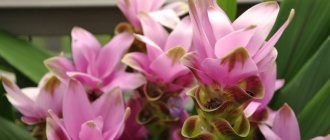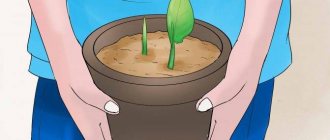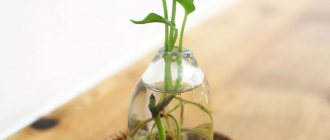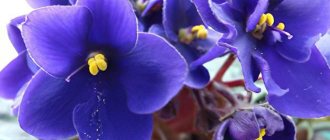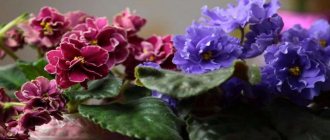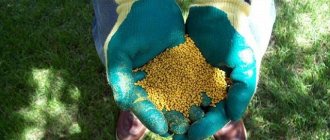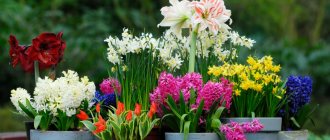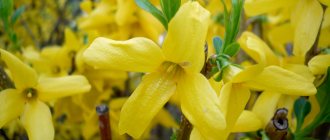The herbaceous plant poppy (Papaver) is a member of the Poppy family. This genus includes more than 100 species. The homeland of this plant is considered to be Southern and Central Europe, Australia and Asia. Poppies are naturally found in regions with temperate, subtropical and cold climates. They also prefer to grow in dry places, for example, in deserts, steppes, semi-deserts, and also on rocky and dry slopes. This flower is cultivated as an ornamental and medicinal plant. In a number of countries, poppy cultivation is prohibited, since most of its species contain narcotic substances. In some countries, poppies are grown on an industrial scale to produce opium, which is extracted from unripe pods. Opium is used as a raw material for the production of painkillers and sleeping pills.
Already in Ancient Rome it was known that poppy had healing properties; at that time, opium, or more precisely, its hypnotic effect, was studied. There is information that the scientific name of this plant was derived from the Latin word “papa”, translated as “father”, this was explained by the fact that to calm a restless crying child, poppy seeds were added to his food.
In the Muslim countries of Asia Minor in the Middle Ages, the consumption of alcohol was prohibited; instead, opium was smoked there. Over time, this tradition became widespread in eastern countries, and today China is the largest consumer of opium. The Chinese government in 1820 introduced a ban on the import of intoxicating poison, but after some time, when the “opium” war with England was lost, the import of opium was again allowed. The fact is that England had enormous profits from the supply of this product to China. Today, the cultivation of soporific poppy is carried out in India, Asia Minor and Central Asia, China and Afghanistan. And decorative poppies, as well as their hybrids, are popular among gardeners. This plant can often be seen in rock gardens or flower beds.
What does a perennial decorative poppy look like?
Poppy flowers resemble bright flashes of fire
Poppy is a plant with large, straight shoots (hairy and bare), pinnately dissected and whole foliage, and a tap-type root system. The leaves have a small hairy-bristly edge. The flowers are regular in shape, with many thin stamens located on oblong peduncles.
Flower buds are usually solitary, but in very rare cases they can be collected in paniculate-type inflorescences. The petals, in most cases, are colored orange, pink, white, red, yellow. The club-shaped fruits contain many seeds. At the end of the ripening period, the seed capsule opens and the seeds scatter in different directions, far from the flower.
Note! The germination period of collected seeds is 4 years.
Which family does it belong to?
Ornamental perennial poppies (genus Papaver) belong to the Poppy family. The plant's homeland is considered to be Southern and Central Europe, Asia and Australia. In the wild, field poppy takes root well in places with cold, subtropical and temperate climates. Gardeners look at it not only as a decoration for the estate, but also as a medicinal plant.
Briefly about the history of appearance
The first mentions of poppy are found in the history of Ancient Greece. The ancient Romans, Babylonians and Egyptians considered it a garden flower and grew it as a remedy for evil spirits and a symbol of fertility. The seeds of the plant were used as a sleeping pill, and the petals were filled into brides' shoes and used for fortune telling. A description of this culture is found in ancient treatises dedicated to the Persian Paradise and the biblical Eden.
Plant characteristics
Blooming decorative poppies
The flowering period begins in April, May or June. The fruits of some crops ripen in July, some varieties bear fruit in August. The large flowers of decorative poppies contain large quantities of pollen. Another sign of decorativeness is the rapid shedding of petals. Opening early in the morning, they fall off in the evening.
The faded flower forms an elongated capsule with jagged edges and many small seeds inside. If the owner’s plans include collecting seeds, the boxes are not touched and left to ripen.
Important! The rhizome of an adult plant grows quite deeply and tenaciously into the ground, so mature crops do not tolerate transplantation to a new place. To avoid damaging the root, many gardeners grow poppies in a permanent place for several years.
Decorative poppy seeds are very small and for this reason they are sown after first mixing them with river sand in a ratio of 1:5. This trick is rarely justified and the hatched seeds have to be thinned out. The distance between seedlings should be at least 5 cm. When thinning poppies a second time, gardeners increase the distance to 20–25 cm. Ignoring this stage leads to plants growing too long and frail.
The petals of the plant are rich in vegetable fats (no more than 44%), organic acids, glycosides and flavonoids.
Benefits and harms
Doctors who lived almost 4 centuries ago spoke about the beneficial properties of poppy. In folk medicine, certain parts of the plant are used as a sleeping pill, analgesic, anti-inflammatory and expectorant. In ancient times, a decoction of it was used to destroy warts and cure fever and swelling of the joints. Poppy seeds are still used to make confectionery and dressings. Poppy flowers contain vitamin C.
The milky secretions from unripe capsules have long been considered a particularly valuable product. This peculiar juice is used to prepare painkillers and cough medicines.
Collecting poppy pods
The genus Papaver includes more than a hundred species of poppy, some of which are dangerous to humans due to their high content of psychotropic and narcotic substances. Poppy is widely known as a source of opium, morphine, codeine and papaverine. The first two components are considered drugs that cause persistent addiction. In medicine, opium and morphine are prohibited from being prescribed to patients suffering from acid starvation of the blood, those undergoing treatment for emphysema, bronchial and liver diseases, and alcohol and drug addiction.
Important! Poppy seeds, contrary to popular belief, are not a narcotic drug. They have a mild hypnotic effect and are not recommended for children under 2 years of age or the elderly.
Properties of poppy: harm and benefit
Useful properties of poppy
Already many hundreds of years ago, the properties of the opium poppy were known. A drink was prepared from the seeds of such a plant, which was used as a sleeping pill and an analgesic. This plant was also especially popular in Ancient Greece: myths say that poppy seeds were always carried with them by the god of dreams Morpheus and sleep Gipson, and also by Hera, the goddess of fertility. During the reign of Charlemagne in Europe, poppy was highly valued, so peasants were obliged to hand over 26 liters of seeds of this plant to the state. It was used to treat sick people and was also given to children to help them sleep better. At that time, no one knew that poppy seeds were unsafe. In the 16th century, Jacob Theodorus, who was a botanist and physician, wrote the book “The Juice of Poppy Seeds,” which described both the benefits and harms of poppy seeds.
Poppy seeds contain fat, sugars and proteins, vitamins E, PP, elements cobalt, copper, zinc, phosphorus, iron and sulfur, while the petals contain fatty oil, vitamin C, alkaloids, glycosides, anthocyanins, flavonoids, organic acids and gum. Among the most valuable vegetable oils is poppy seed oil. It is used in the production of cosmetics and paint.
Blue poppy seeds are used as an expectorant, and a decoction is also prepared from them, which eliminates pain in the ears, as well as toothache. Preparations from poppy seeds are used in the treatment of insomnia, pneumonia, liver disease, gastric catarrh and hemorrhoids. A decoction of poppy roots is used to treat migraines and inflammation of the sciatic nerve. A decoction of the seeds is used to improve digestion. This plant is used for excessive sweating, bladder inflammation, dysentery and diarrhea. The following potent medications are produced from poppy seeds: Morphine, Narcein, Codeine, Papaverine and Narcotine. They should not be used without prior consultation with your doctor.
Classification of popular perennial poppy species
Shrub rose in a pot - can it be grown at home?
Poppy is one of the most vibrant flowers. Until relatively recently, it served as a decoration for gardens, orchards and fields. The flowering period begins in the first days of summer. Today, most gardeners do not dare to plant them on their plots for fear of attracting the attention of drug addicts. Only some species containing minimal amounts of narcotic substances are actively cultivated. All poppies do not tolerate frequent transplants.
Oriental perennial or Turkish poppy (Papaver orientale)
Tall (up to 90 cm) perennial. It reaches a meter in diameter. The foliage is beautiful, pinnately dissected, coarsely hairy. During the flowering period it is covered with single, large double, semi-double and single flowers. It can be distinguished from other poppies by large black spots in the inner part of the flowers and stamens with the same coloring. Different types of oriental poppy may differ in flower shape and color.
A rosette of leaves is formed in May, and flowers appear in June-July. In August, the foliage dries out, and after the end of the flowering period, a small box forms in place of the flower. By September, the leaf rosette may form again, and in some cases the flowering period is repeated, but full-fledged flowers rarely appear.
Alpine (Papaver alpinum)
A variety of alpine poppy
The shortest and short-lived perennial that renews itself by self-seeding. The maximum height to which alpine poppy can grow is 30 cm. It blooms earlier than other poppies - in May-June. The maximum lifespan of one plant is 3 years. It blooms mainly with white and yellow flowers, the diameter of which can reach 5 cm. It takes root well in rock gardens.
Important! Alpine poppy is picky about soil, preferring well-drained limestone.
Hollow poppy (Papaver nudicaule) or saffron poppy (Papaver croceum)
A short-lived perennial (maximum lifespan is 3 years), which reproduces well by self-sowing. The bluish foliage of the plant is collected in a rosette. The maximum height of peduncles is 30 cm, the diameter of flowers is 5 cm. It blooms in white, yellow, orange from May to September.
Poppy (Papaver rupifragum) or Spanish poppy (Spanish Poppy)
A perennial plant, it is widely known among gardeners due to its long flowering period (blooms all summer) and dense foliage of a silvery hue. Needs regular removal of dried inflorescences. Blooms most abundantly in June.
Pink and purple varieties
Perennial Arabis - how to grow and care
These shades are quite unusual for poppies, the more interesting they look on the site.
Cedric Morris
A very good perennial variety for the garden. The peach-pink semi-double corolla reaches 15 cm. The petals at the base are deep purple. The stamens are also dark purple.
Papaver Cedric Morris
Mrs Perry
Frost-resistant perennial with salmon-colored large fragrant flowers. The ruffled petals have dark strokes at the base.
Papaver Mrs. Perry
Patty's Plum
Tall perennial with large flowers, up to 18 cm in diameter. The ruffled plum petals have an anthracite base. Height up to 80 cm.
Variety Pettis Plum
Karine
The flowers of this variety are cup-shaped, powdery pink, with a burgundy spot at the base of each petal. Bush height up to 60 cm.
Eastern variety Karin (Karine)
Roseum
Hybrid saffron papaver, pink in color, up to 40 cm tall. Flower diameter 6 cm.
Varieties of perennial poppies that are most popular among gardeners
Garden poppy is an ornamental plant and very beloved by gardeners. It is often used to decorate cottages and park areas.
Beauty Queen
Money tree - what it looks like, can it be kept at home?
During the flowering period, it is abundantly covered with saucer-shaped flowers of a light orange hue. The maximum height of the peduncle is 90 cm.
Black and White
The flowers are showy, corrugated, white, large in size. The core is black.
Blue Moon
The height of an adult bush is almost 100 cm. It blooms with large pink flowers. The petals have a slight bluish-blue tint, and there is a black spot at the base of the inflorescence.
Cedric Morris
It blooms with large, delicate purple flowers with a black spot in the middle. Petals are corrugated. The approximate height of the peduncles is 80 cm.
Additional Information! Large flowers of rich colors go well with relatives and other plants.
Kerlilock
During the flowering period it is covered with orange, slightly drooping flowers. There is a black spot at the base of the petals with a jagged edge. Peduncles grow up to 70 cm.
Allegro
Oriental poppy Allegro
Blooms with orange-red flowers collected in rosettes. Peduncles can grow to a height of 70 cm.
Garden Glory
One of the most decorative varieties of oriental poppy. Known for its soft pink flowers with a dark center. Petals are corrugated, terry. The maximum height of peduncles is 80 cm.
Mrs Peri
During the flowering period, it is covered with medium-sized pink flowers, in the central part of which there is a black spot. The height of the peduncles is about 90 cm.
Pettis Plum
Blooms in May. Plum colored flowers. The maximum height of peduncles is 70 cm.
Caryn
With the onset of the flowering period, it becomes covered with salmon-pinkish, small saucer-shaped flowers. They are located near the leaf rosette. Peduncles grow 60 cm high.
Popscale
It is a bush up to 25 cm high with powerful, stable peduncles. Bright flowers reach 10 cm in diameter.
Cardinal
Holostem poppy variety. A bushy plant up to 40 cm high. The variety owes its name to scarlet flowers, which at the height of the flowering period reach a diameter of 6 cm.
Sulfureum
Bush up to 30 cm high. The diameter of the bright lemon-colored flowers is approximately 6 cm.
Atlant
A low-growing bush that grows to a height of 20 cm. The diameter of the flowers is 5 cm. It blooms with white and yellow flowers.
Roseum
During the flowering period, bushes 40 cm high are covered with pale pink flowers with a diameter of about 6 cm.
Oriental poppies with white flowers
The “ancestors” of the white varieties were pink, as evidenced by the shy blush...
More than a century later, the first variety of white perennial poppy, ‘Perry’s White’, bred by Amos Perry in 1913, remains a “hit of all times”, a much later variety. “Louvre” ('Louvre', variety series 'Parisienne' – “Parisian”) - looks almost the same from the photo. The same two rows of corrugated petals, the same spots at their base. The white petals have a slight pink tint, reminiscent of the original pink varieties. The difference between Louvre is its compact bush; the variety is included in the top compact poppies according to the authoritative nursery Darwin's Plants. The new extra-white variety 'White Goose' is part of a new group of Super Poppies, which will be discussed below.
Popular types of annual poppies
Money tree - can you keep it at home, what does it bring, can you give it away?
Annual poppies are not afraid of cold weather, so many gardeners sow them in late autumn or early spring. Shoots appear 10–15 days after sowing the seeds in open ground. Seeds collected after the end of the flowering period can be stored for up to 4 years without loss of germination.
Important! Annuals prefer well-lit, fertile garden areas containing lime.
Soporific poppy (Papaver somniferum), or opium poppy
The flowers, reaching a diameter of 9–10 cm, can be colored, depending on the variety, lilac, pink, purple, white, lilac or red. Some specimens have black or white spots at the base.
Hybrid (Papaver hybridum)
Hybrid poppy variety
It reaches a height of 30 cm. During the flowering period it is covered with rare, dark red 4-leaf flowers with a black core.
Samosa poppy (Papaver rhoeas)
Grows to a height of 60 cm. The basal foliage is serrated, pinnately divided. The stem foliage is tripartite, with pinnately dissected lobes. Both the foliage and stem of the plant are coarsely hairy. During the flowering period (from June to September) it is covered with simple or double flowers with a diameter of 5–7 cm, pink, purple, salmon or white. Some varieties have a dark spot at the base of the petals.
Peony poppy can be considered one of the tallest annuals. The height of some species reaches one meter.
Diseases and pests
Oriental poppy is susceptible to the following diseases:
- Spotting;
- VTM;
- Bacteriosis;
- Powdery mildew;
- Rot - root, gray, white.
In the initial stages, environmentally friendly, safe biological products are used - Baktofit, Planriz, Trichodermin. Affected plants are treated against fungal infections with Fundazol, Quadris, Ordan.
Selection of funds taking into account diseases:
| Diseases | Examples of drugs |
| Downy mildew | Medex Soda solution Copper chloride |
| Alternaria blight | Oxychloride Kuproxat Skor Fundazol |
| Fusarium wilt | Topsim Benomyl Fundazol |
| Powdery mildew | Quadris Bordeaux liquid Pure flower |
Plant pests include earwigs, moths, and thrips. Nematodes and helminthosporiosis cause trouble. Bushes are sprayed against insect pests:
- Bona forte;
- Bitoxibacillin;
- Verticillin.
Tank mixtures reduce the number of irrigations. Insecticides have a good effect - Profi, Akarin, Aktofit, Zolon.
What does the law say about growing oriental poppies?
According to the law, it is prohibited to cultivate plants containing narcotic compounds on the site. And even if poppy seeds are purchased from an agricultural company, problems with the organs may arise - flowers with large capsules measuring 2-5 cm are prohibited. Oriental beauty contains a phenolic alkaloid of morphine-like substances - oripavine. The fine is imposed for the presence of more than 10 plants in the garden; it can range from 1,500 to 2,000 rubles. Small plantings of 1-5 flowers do not fall under the criminal code.
In Ukraine, only the soporific poppy is prohibited, while the oriental poppy is allowed to be cultivated. In Belarus, the ban on oriental poppy applies, as does all plants with oripavine. Oriental poppies look attractive in mini flower beds, lawns and garden beds. Their bright beauty captivates flower growers and designers. Flowers are skillfully combined with late-flowering perennials, shrubs, and included in original bouquets. There is nothing complicated in growing - the main thing is to ensure that the water does not stagnate and periodically apply fertilizers.
Currently reading:
- Using hydrogel in open ground for plants
- Choosing cucumbers for open ground according to your preferences
- We care for the heat-loving Californian poppy (Eschscholzia)
- How to grow Chinese cabbage in open ground
Share the news on social networks
About the author: Victoria Semyonovna Nakhodkina
Leading researcher at the laboratory of vegetable and berry crops, Yakut Scientific Research Institute of Agriculture, Siberian Branch of the Russian Academy of Agricultural Sciences, Republic of Sakha (Yakutia).
How perennial poppies reproduce
The key to lush and long-lasting flowering of the decorative perennial poppy is proper planting and care. A perennial can grow in one place for 10 years or more, but experienced gardeners replant it once every 5–7 years. The plant can be propagated by seeds, seedlings and dividing bushes.
Note! If the gardener plans to transfer an adult plant to a new place, he must thoroughly clean the former “place of residence” of the poppies, removing even tiny pieces of rhizomes. The remains of the plant will germinate easily and will soon spread throughout the area.
Growing from seeds
One of the most popular methods of plant propagation. To ensure that the seed dissipates on its own, flower growers leave fruit boxes on faded plants. Self-seeding will occur next year. Most gardeners prefer to collect seeds and sow them by hand.
The seeds are scattered over a previously dug area and lightly crushed with loose soil. If the seed is buried too deeply in the soil, it will not have enough strength to germinate.
Time to board
The crop can be sown in spring and autumn. Autumn sowing is carried out in previously prepared soil. Stratification is useful for seeds, so in regions with a mild climate it is advisable to carry out work in the fall. Spring sowing in open ground is carried out early, before the onset of stable heat.
It is best to plant adult perennials in May or September, before or after the flowering period.
Selection of capacity
Germinating poppy seeds
Seeds do not have to be sown immediately in open ground. In early spring, they can be germinated in a plastic tray, a peat cup or a special “tablet” filled with a nutrient substrate. The seeds are scattered over the surface of the soil, lightly pressed into the ground and covered with polyethylene. When the seedlings sprout, which will happen in 14–15 days, they will need coolness and good lighting.
Preparing soil and seed
Both neutral and slightly acidic soil are suitable for sowing. It is desirable that the soil is light and crumbly, loamy or sandy loam. Having matured, the flower can develop safely in any soil.
The crop can survive for a long time without watering, but the lack of moisture will certainly affect the quality of flowering. With abundant watering, stagnant water can damage the root system of the plant.
The soil intended for planting must be fertilized with humus at the rate of 5–10 kg per square meter. Feeding with minerals will also be required. 30–50 g of fertilizer must be added to each square meter of land. The fertilized soil is dug up by plunging the shovel into the soil to a depth of 30–40 cm.
Note! Seeds are collected after the leaves of the plant wither or turn yellow, and the capsule dries out and cracks at the base of the cap (small holes should form between the base and the cap). Seeds ready for planting acquire a dark gray, almost black color.
Sowing all types of poppies requires compliance with the following rules:
- do not allow water to stagnate;
- Do not plant seeds in places with close groundwater.
Seedling care
The beds with hatched seedlings are fed 1-2 times during the season. The soil in which poppies are planted must be regularly loosened (while simultaneously removing weeds), ensuring air flow to the rhizomes, and mulched (preferably with peat).
Dive and transfer
poppy seedling
After the formation of the 2nd true leaf, the seedlings are dived, trying not to damage its parts. The plant does not like transplants and will die if handled carelessly.
Planting in a permanent place is carried out after the appearance of the 5th leaf. The culture is dug up along with a lump of earth and carefully transferred to a new place.
Additional Information! Some varieties bloom in the year of transplantation, some - 2-3 years after sowing the seeds.
Dividing the bush
The bush is dug up along with a lump of earth and divided into several parts. Given the fragility of the rhizome, this work must be done very carefully. Parts of the flower are immediately transplanted into pre-prepared holes. The permissible distance between the two nearest holes is 50–70 cm.
Choosing a landing site
It is worth taking a responsible approach to resolving this issue, since the oriental poppy is very sensitive to transplantation, like all other tap-root perennial flowers. Therefore, you will have to plant the poppy in a permanent place and expect a decorative effect no earlier than after 2 or even 3 years, but it will amaze with its beauty and size of flowers for about 7 years, after which it is advisable to renew the bush.
You will need to take care in advance about temporarily replacing the long-lived plant with some kind of annual, since after flowering, only the root system of the poppy remains viable, and the shoots will dry out completely. When choosing an annual crop, you need to know that early poppy varieties bloom in May-June, and late ones in June-July.
It is preferable to plant the bush in sunny places, although it will grow well in shaded areas. The perennial grows well on sandy soil; stones in the soil will not be an obstacle either.
Features of garden care
The tops of large specimens at the beginning of the flowering period will be weighted with buds, so they will need support. To tie poppies, it is recommended to use wide ribbons made of natural fabrics, since thin or nylon ropes can easily damage the stem.
After the flowering period is over, the dead parts are cut off at ground level. The seeds are collected after the fruits ripen.
Young plants need special care - they need to be watered frequently. The divided bushes should spend the first winter under cover of dry leaves and spruce branches. In the future, plants will be able to overwinter without shelter.
Poppy can withstand frosts down to -40°C. Mature bushes do not require additional shelter for the winter, but the safety of rare varieties should be taken care of; they should be covered with dry leaves for the winter.
What conditions do poppies like?
Perennials such as oriental poppy prefer loose, sandy loam soil in which water does not stagnate. If the soil is deprived of nutrients and its acidity is increased, the flowers will become smaller every year. The most suitable place for planting is areas flooded with sunlight. The plant will not disappear in the shade either, but the buds will set worse.
Important! Some crops, when planted in shaded areas, refuse to bloom.
What is the plant afraid of?
In general, poppy is an unpretentious plant, but in order to achieve abundant and long flowering, the gardener must water the beds on time, trying not to flood them. The plant is afraid of both prolonged drought and stagnation of water.
Watering
It can go without watering for a long time, but the lack of moisture affects the quality of flowering. With abundant watering, stagnant water can damage the root system of the plant.
Mulching
Poppy in the garden
The land in which poppies grow is mulched with peat, but in the absence of peat, you can use any mulch. Mulching relieves the gardener of the need to regularly water the beds and get rid of weeds.
Loosening
Loosening must be carried out before sowing poppies and in the process of caring for adult flowers. The earth is loosened to a depth of 3 cm.
Feeding
Feeding is provided by humus and minerals. The first is scattered over the land in such a way that for each square meter there are 10 kg of fertilizers. Minerals are distributed in such a way that there is at least 30 g per 1 square meter.
Transfer
The flower is replanted carefully so as not to damage the root system. They dig it up together with a lump of “native” soil and immediately transplant it to a new place. The recommended minimum distance between the two closest plants is 50 cm. It takes root well in places where large-leaved hydrangea (hydrangea macrophylla) was previously grown.
Caring for young poppies
Poppies are drought-resistant, hardy and generally unpretentious plants. One point of care is very important for young seedlings, and even adult poppies - timely weeding, since poppies will not be able to compete with other aggressive plants.
If sowing was carried out in the spring, then until the plants become stronger, they need to be protected from drought. Both fall-sown and adult poppies in the active growing season respond well to additional watering, but the main thing with moisture is not to overdo it, just providing protection from drought. If the plants are very tall or the site is windy, then it is better to tie the stems to supports as they grow.
There is no need to cover young poppies during the first winter.
Decorative poppies also require other aspects of care:
- loosening the soil;
- feeding (at least one spring or 2-3 feedings per season)
Young poppy bush. ©Jason
When and how does it bloom
The flowering period for most poppies is throughout the summer months.
Types of flowers
Many experienced gardeners and hobbyists plant the following species on their plots:
- Oriental;
- holostem.
Flower shapes
Oriental red poppies have 4–6 petals, almost round in shape. The petal length is about 9 cm. Their color varies from orange-fiery red to pink-red. There may be a black, almost square spot at the base of the petals. The stamens are dark, slightly widened at the top, and the anthers are oblong and purple in color.
The flowers of the poppy can be yellow, orange, and sometimes white. The diameter of the obovate, simple or double petals reaches 6 cm.
Additional Information! The stamens emit a subtle aroma.
Flowering period
The flowering time of the oriental poppy is June–July. The holostem poppy blooms in May and blooms until autumn.
Changes in care during the flowering period
Caring for flowering plants comes down to moderate watering and removing weeds (in the absence of mulch).
Botanical description
Poppies are annual, biennial and perennial rhizomatous herbaceous plants. The poppy root has a tap root, going deep into the ground, and the suction roots located on the periphery are easily broken off during transplantation. The stems of the poppy are straight and strong, bare or pubescent, the leaves are alternate or opposite, entire or pinnately dissected, most often covered with hairy-bristly pubescence. Regular apical flowers with numerous stamens, located on long and strong peduncles, usually solitary, but in some species they are collected in paniculate inflorescences. The petals of the flowers are large, whole, colored red, orange, yellow, pink, salmon or white.
The poppy fruit is a club-shaped capsule with seeds, “clogged” with a convex or flat disk. When ripe, the capsule bursts and the seeds are thrown out a considerable distance. Poppy seeds remain viable for 3 to 4 years.
Possible problems in growing
Poppies are not able to fight some infectious diseases and garden pests. For preventive purposes, plants are irrigated with preparations that contain copper: Bordeaux mixture, copper sulfate (copper sulfate), contact fungicide (Maxim), systemic fungicide (Topaz). Prevention is carried out before the flowering period.
Pests
Poppy sneaker
Poppy secretive proboscis and other beetles from the weevil family love to settle in the root system and leaves of poppies. It is extremely difficult to detect them - upon sensing the approach of a person, insects fall to the ground, merging with lumps of soil. Gardeners recognize their presence by external signs: the affected plant stops growing, and its lower foliage turns yellow and dies.
Pest control consists of spraying with 0.2-0.35% chlorophos: 2-3 treatments with an interval of 10 days are sufficient.
Diseases
Crops cannot resist the formation of powdery mildew and black fungal spot.
Signs of improper care
Before or after sowing seeds, the soil must be treated with insecticides. If this is not done, pest beetles may settle in the root system and on the lower foliage. Soil treatment with 7% chlorophos or 1.6% phosphamide on granulated superphosphate (10 g per square meter) can be carried out even after the seeds have sprouted.
Poppies planted in a too shaded part of the garden practically do not bloom due to the slow setting of flower buds. The absence of flowers may be a sign of improper care: although the plants are considered unpretentious, they periodically need watering, weeding and mulching.
Why doesn't poppy bloom?
There may be several reasons for this:
- the time is not right (poppies grown from seeds bloom in the 2nd, and sometimes even in the 3rd, year after sowing);
- the plant does not have enough sun;
- roots are damaged (for example, during loosening);
- the bush was replanted and needs time to adapt to new conditions.
Oriental poppy may not bloom due to lack of sunlight.
Use in landscape design
Designers use poppies to decorate green lawns and flower beds. They get along well with ornamental cereals, delphinium, Chinese chrysanthemums, mantles, geraniums, cinquefoil, milkweed, all lilies, cosmos, tobacco and lavatera.
Many amateur gardeners are concerned with the question: is it possible to grow poppy in the country? The law prohibits the widespread cultivation of poppy (Papaver somniferum), oriental poppy (Papaver orientale), bract poppy (Papaver bracteatum) and bristlecone poppy (Papaver setigerum). Experts do not recommend gardeners to cultivate all types of poppy with too large seed pods - these are the ones that pose the greatest danger.
Poppy is dangerous
Alas, some types of poppy are distinguished not only by their beauty and obvious benefits.
In many countries, Papaver somniferum L. (soporific poppy, also known as opium poppy) has been cultivated for thousands of years, from the unripe pods of which opium is obtained - a thickened milky juice containing powerful painkillers that quickly become addictive.
On the one hand, opium serves as a raw material for the manufacture of medicines, on the other hand, for the production of the terrible drug heroin.
Smoking opium for the purpose of intoxication and pain relief (remember, we talked about the symbolism of sleep and death) began for the first time in the Middle Ages in the Muslim countries of Asia Minor, where alcohol was banned, and from there it spread further to the East and West. For example, the profits from the sale of opium to China were at one time so great that when the Chinese government banned the import of opium into the country, the British launched a real war to regain their opium privileges (America actively supported them) - and they still won.
Opium can only be obtained by hand, which explains its high cost.
Currently, the main areas sown with opium poppy are concentrated in the so-called Golden Triangle (Northern Thailand, Laos, Burma), as well as in Afghanistan.
In the Soviet Union, industrial poppy plantations were located in the Kyrgyz SSR. In 1953, the USSR even became one of the seven countries to which the UN officially allowed the export of opium. In Russia, since 2004, it has been prohibited to cultivate this type of poppy, which contains narcotic substances, for which Article 231 of the Criminal Code of the Russian Federation is provided.
Even if there is at least one plant on your site, the Code of Administrative Offenses comes into force and you face a fine of up to 4 thousand rubles or arrest of up to 15 days. For planting on a large scale (for poppies this is from 10 pieces), criminal liability arises - a fine of up to 300 thousand rubles or restriction of freedom for up to two years. For especially large plantings (from 200 pieces), the punishment is toughened - the term of imprisonment increases to eight years.
What does an opium poppy look like? It is a large herbaceous perennial, about 1 m tall, with few branches, with erect, smooth bluish-green branches and large simple flowers on long peduncles. Alas, only by the appearance and color of the flower you can hardly distinguish the soporific poppy from another - over many years of cultivation, many of its forms and varieties have been bred with simple and double flowers, with incised, corrugated or split petals, with red, pink, purple flowers, white. The only thing is that you are unlikely to be offered to buy it in a regular gardening store.
But here’s the bad news: other poppy varieties banned in Russia may be offered. Moreover, it is completely legal, since in practice it is extremely difficult to distinguish narcotic poppy seeds from decorative ones. And if law enforcement agencies decide to check your bright flowerbed, for example, following a tip from “good neighbors”, and opium compounds are found in the tissues of the plant, then your further fate will depend on the size of the poppy plantings - read above.
Be careful! Along with opium poppy, three other species of this plant are prohibited for cultivation on the territory of the Russian Federation as they contain narcotic substances. This:
- Papaver setigerum DC – bristlecone poppy (annual with elegant purple-pink flowers with a dark spot at the base);
- Papaver bracteatum Lindl. – bract poppy (perennial with blood-red flowers with a black spot at the base);
- Papaver orientale L. – oriental poppy (perennial).
And if the first two types of poppy are rarely found on the shelves, then the oriental poppy with thick, pubescent, few-branched stems and large bright flowers is a popular unpretentious ornamental plant and its seeds are sold freely (by the way, their sale or storage is not a violation of the law).
And for all these types of poppy, today there are many garden forms and varieties “for every taste and color” - by appearance, a non-specialist will not be able to distinguish a “forbidden” poppy from a “permitted” one. Therefore, strictly speaking, any poppy flower on your property can become a reason for proceedings with law enforcement agencies, according to the State Drug Control Service.
A conditional sign that a flower is “narco-dangerous” can be its fruit-pods, which are usually larger (2-5 cm in diameter or more) than those of other species. But you yourself understand how reliable this is.
So, whether or not to sow any poppy in your flower beds is up to you to decide. He who is forewarned is forearmed. At least we have provided you with knowledge.
At a minimum, when purchasing seeds, be vigilant and carefully read the information on the packaging.
